Char Dham Yatra, Uttrakhand – the MOST COMPLETE GUIDE
[ad_1]
Char Dham Yatra in Uttarakhand is collectively referred to as the Chota Char Dham of India. The four Abodes in Himalayas includes four holy shrines of Hindus: Badrinath, Kedarnath, Gangotri and Yamunotri. All four of these temples are situated within the Garhwal region of Uttarakhand. The prominence of the Charm Dham Yatra is immense amongst Hindus. Moreover, it is believed that every Hindu should do Char Dham Yatra at least once in their lifetime.
One the most popular pilgrimage route, Chota Char Dham Yatra is undertaken by quarter of a million of devotees each year paying homage. With the hope of eliminating all sins to attain salvation by the blessings of the Lord. In fact, devotees visit the shrines not only from India, but, also there is immense growing popularity among foreign tourists, visiting out of curiosity and wanting to learn more about India, its culture.
Given the stunning beauty, the Himalayan charm, dense forests, large valleys and epic nature all around – Char Dham Yatra makes for the most majestic of journeys to partake in.
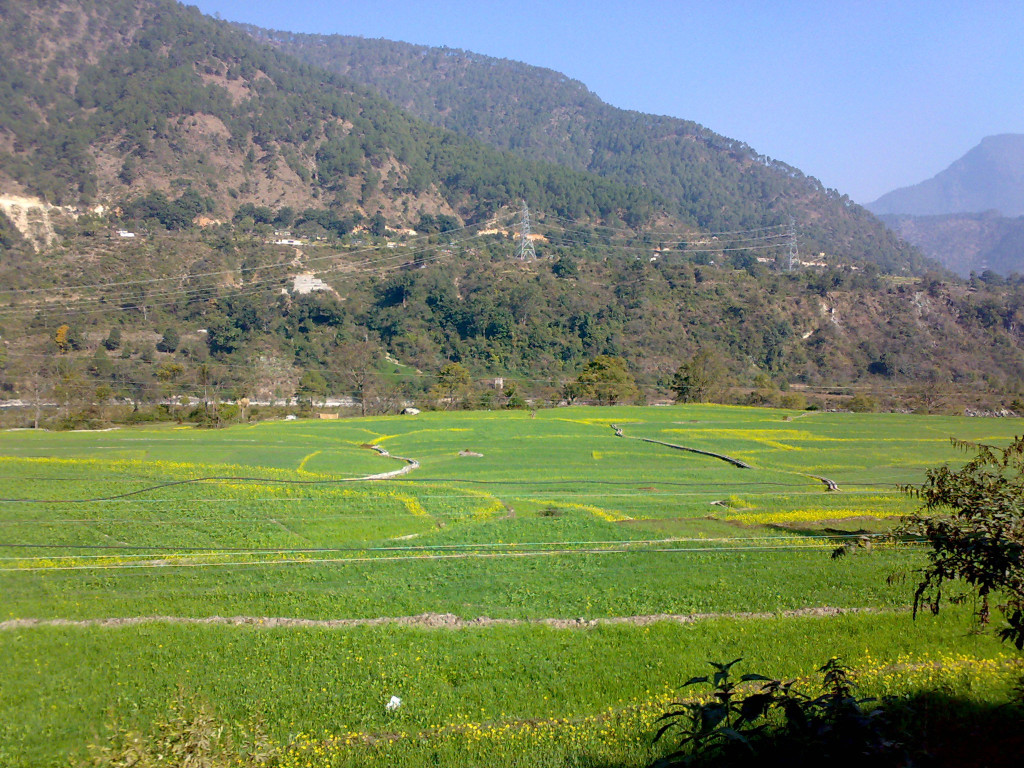
About Char Dham Yatra
As a brief, Kedarnath is devoted to Lord Shiva while Badrinath is devoted to Lord Vishnu. Yamunotri and Gangotri are dedicated to Goddesses Ganga and Yamuna rivers respectively.
Char Dham Yatra of Uttarakhand can be covered in one go, taking about 10-15 days (depending on your schedule). In fact, you may also get helicopter services to cover Char Dham in a matter of two days.
History of Char Dham
The Great Reformer and Philosopher, Adi Shankaracharya, gathered together these Holy Pilgrimage places into a spiritual circuit around the 8th century. Generation followed generations and hundreds of thousands of devotees have kept up the tradition of covering these pilgrimage spots every year. However, it should be noted that during Winter season all Char dham are closed for Six month due to Heavy snowfall all temples are inaccessible. The Gods and Goddesses are moved to their “Winter abodes” during this time.
Opening and Closing Dates of the Yatra
Usually, the period for partaking in this Yatra is from April End – October End. However, each year the Uttarakhand Government announces the dates of the opening and closing of the circuit. In the winter times, the 4 shrines are moved to their winter sojourns. Namely, Ukhimath, Joshimath, Mukhba and Kharsali for the deities of Kedarnath, Badrinath, Gangotri and Yamunotri respectively. The gates to all these winter Dhams remain open for devotees – thus, technically you may visit the shrines all year long (albeit not in the same locations)

How to get there
In order to embark upon the Chota Char Dham Yatra, you’ll need to reach Haridwar. Here’s how.
By Air
Jolly Grant Airport, Dehradun is the nearest airport. In fact, from here, you may even take up a Helicopter service to Kedarnath and Badrinath. These are available from Delhi, Dehradun, Phata, Augustmuni and Gauchar near Rudraprayag and Dehradun.
By Train
Rishikesh, Haridwar, Kotdwar and Dehradun are well connected to major cities of India by Railway Network. From here you can get bus or you can hire taxi as well towards your onwards journey.

Char Dham Yatra Route
As per the Hindu Mythology, the auspicious and ever-so-important Yatra should be undertaken from west to east, in order to cover the holy places in a clockwise manner. Thus, it means that you should start off your pilgrimage from Yamunotri, then proceed to Gangotri, Kedarnath and finish your journey at Badrinath.
About the Char Dham Yatra
While the journey is a beautiful one, I want to highlight the importance of each of the shrines.
Yamunotri Dham
The original source of Yamuna River, Yamunotri is surrounded by stunning high forested peaks and a large valley. Yamuna is known to be the second largest and one of the holiest river in India after Ganga. As per the Hindu mythology, it is believed that Yamuna is the daughter of Surya (God of Son) & the sister of Yama (God of Death).
It is believed that you will be washed of your sins when you visit Yamunotri. Given the tough journey, faith, and transcendent significance of the river motivates the pilgrims to their destination. Distinctive features of Yamunotri include hot springs where raw rice is cooked and turned into prasad. Also, there many holy shrines, ashrams and temples in and around the Dham.
Yamunotri is located at an altitude of 3293 mts, in the Garhwal region and situated about 40 km away from Barkot in Uttarkashi. While the actual source of Yamuna lies in the Yamunotri Glacier, at an elevation of 6,387 mts near Bandarpunch Peaks.
Other places of interest nearby include Surya Kund, Divya Shila, Janki Chatti, Hanuman Chatti, Saptarishi Kund Lake etc.
History and Importance of Yamunotri
The temple at Yamunotri is dedicated to goddess Yamuna. It should be noted that the main Deity of the temple is made up of Black marble. Built by Maharani Gularia of Jaipur in the 19th century, the current temple was created after the previous one was destroyed by climate activity. The Yamunotri Shrine was originally constructed by Maharaja Pratap Shah of Tehri Garhwal on left seashore of Yamuna River.
Gangotri Dham
Unarguably the most important river for Hindus, Ganga is the most sacred river in the world. Gangotri is one of the origin sources of Ganga (Ganges). It should be noted here that the foremost source of the river is “Gaumukh” – a glacier located 19 km from the Gangotri temple.
Gangotri is located on the banks of Bhagirathi river at an altitude of 3100 mts. Gangotri is the starting point of Ganga. It should be noted that the river Bhagirathi attains the name Ganga from Devprayag. This is where Bhagirathi meets with Alaknanda to form Ganga.
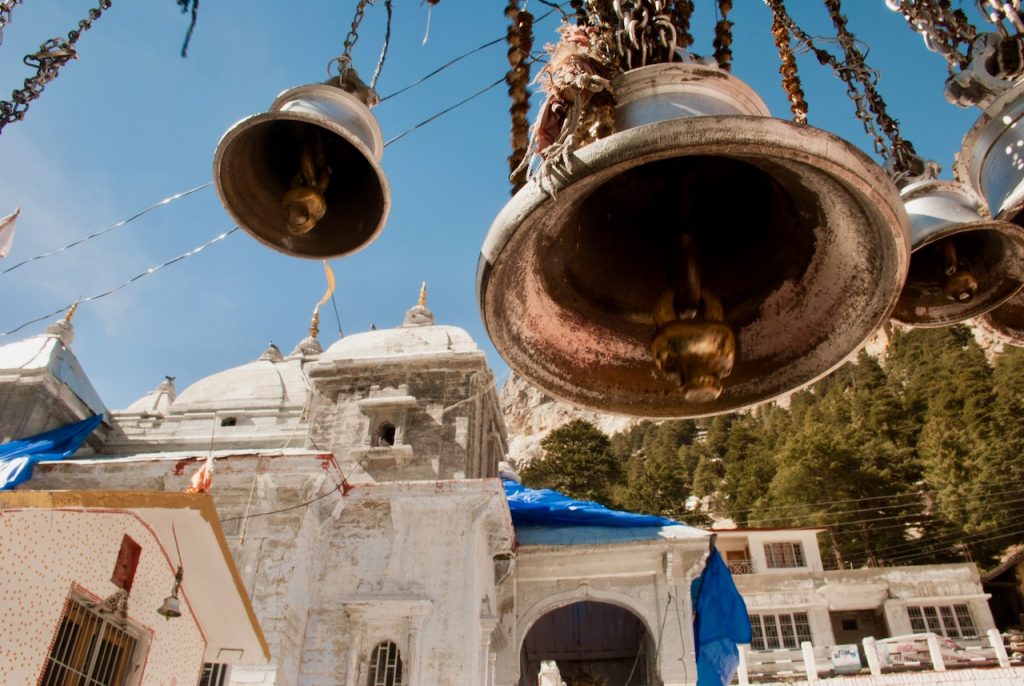
The temple opens on the auspicious day of Akshay Tritiya (usually in the month of May) and closes down on Yama Dwitiya or Bhai Duj (usually falling in October/ November).
Ganga water is the purest form of blessing and is used in Poojas (prayers) or offering in temples. In fact, pilgrims carry the auspicious water from here as a way to carry Prasad and blessings for future prayers. Gangotri is the home place of many varieties of flora and fauna. There are several temples in Gangotri where visitors can learn the history behind the creation of Ganga River.
History and Importance of Gangotri Temple
As per Hindu Mythology, Ganga was born as a result of prize given Shivji to king Bhagirath for his penance. However, owing to her superiority as well as the fact that Earth would be overwhelmed if Ganga came down in full force, Shivji caught her in his locks. There is a sacred stone near the Gangotri temple that denotes the place where Ganga first came down to earth in the river form. This is why Ganga is also called by the name of Bhagirathi (i.e. the daughter of Bhagirath).
The Gangotri temple in its present form was constructed by Gorkha Commander Amar Singh Thapa in the 18th Century. It is believed that at the time of construction of the current temple, the Gaumukh glacier was present here – however it has receded to its current location due to global warming and climate change.
Kedarnath Dham
One of the most sacred pilgrimages in India, Kedarnath temple is located on the bank of Mandakini river at an altitude of 3584 mts. Historically, this region was known as “Kedar Khand”. Kedarnath temple is one of the 12 Jyotirlingas of Shivji in India.
Flanked by breathtaking snow-capped peaks, Kedarnath is the most remote locations on the Char Dham Yatra. The town itself is stunningly beautiful and the scenic beauty tends to attract a lot of pilgrims, with huge crowds flocking the region in the summer months of May and June. Also, the Kedarnatha trek is quite famous amongst the trekker tribe.
It should be mentioned here that the 2013 floods did huge damage to the region. In fact, the fact that the temple is still standing has been the source of massive reverence. Prior to the 2013 floods, Gaurikund was the last destination on Kedarnath route, but with the floods in 2013, a new trekking route is under process. This route will be approximately 21 kms of , which will either start from Sonprayag or Sitapur. As of now, helicopter is the best way to reach Kedarnath temple.
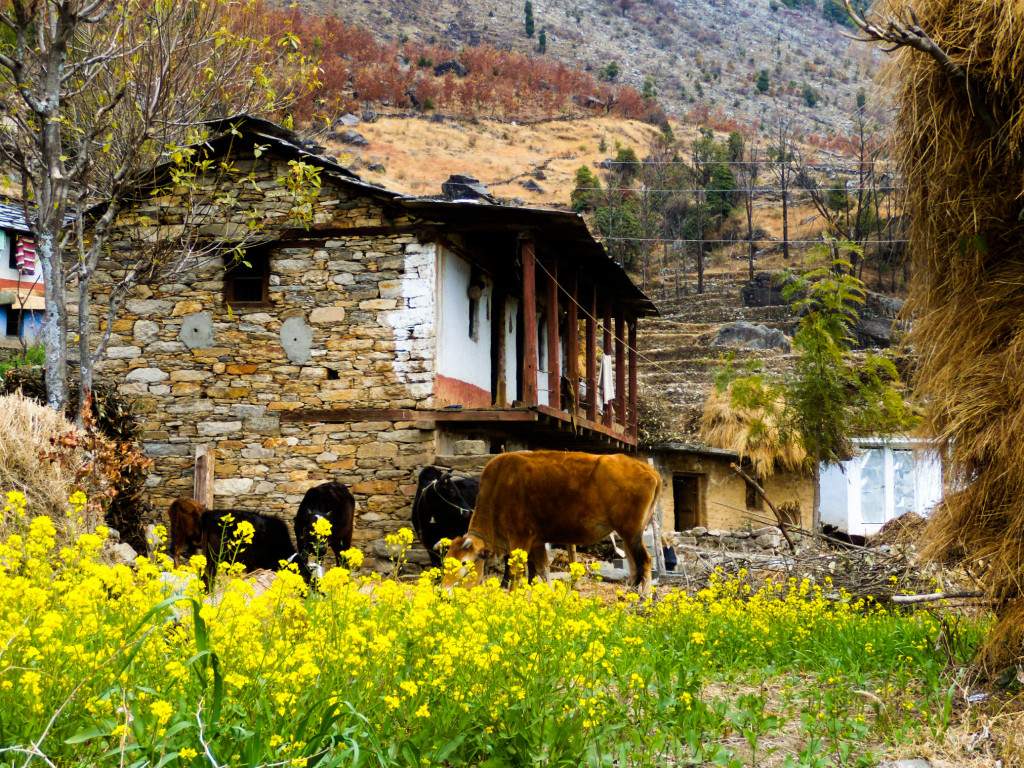
Currently, only accommodation near the dham are campsites due to the excessive damage from the floods.
In terms of thingy to do nearby, you may visit Chorabari tal (Gandhi Sarovar), Vasukital, Gaurikund, Trijuginarayan, Ukhimath, Panch Kedar, Madmaheshwar, Tungnath, Chopta, DeoriaTal and Rudranath etc.
History and Importance of Kedarnath Temple
Dedicated to incarnations of Shivji, Kedarnath is named after King Kedar, a ruler from Satya Yuga. This is the place where Shivji is said to have absolved the Pandavas from killing their own cousins Kauravas in the Mahabharata. In fact, there is an interesting story behind the town and its temple. According to the Puranas, the Pandava brothers did a major penance in Kedarnath to please Shivji.
Earlier the temple was built by Pandavas and Present temple was built by Adi Shankaracharya. Just Behind the temple you will see samadhi of Adi Shankaracharya.
Badrinath Dham
Badrinath is an important holy shrine for Vaishnavites and is one of the 108 divya desams incarnation of Vishnuji. Also, Badrinath the town is part of Panch Badri temples which include Yog Dhyan Badri, Bhavishya Badri, Adi Badri and Vriddha Badri, along with Badrinath temple.
And, Badrinath is situated at an altitude of about 3415 mts in the Chamoli District of Uttarakhand. Located in Silent valley of Garhwal, Badrinath lies on the shores of Alaknanda river. The town is known for its stunning beauty, pleasant weather, thick forest cover as well as the beautiful views of snow clad mountains along the holy river flowing through the surrounding green valley.
Badrinath is the home to many celebrations including Kedar-Badri Utsav, Janam-ashtami, Mata Mruti Ka Mela. Nearby places that should be visited include Panch Prayag temple, Badhri Naryanan Temple, Vasudhara Falls, Hot Geyser (tapt kunds or hot water springs), Bheem Pul, Mana Village etc.
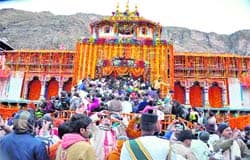
History & Importance of Badrinath Temple
The original Badrinath temple was built Adi Shankaracharya, who initially discovered the Badrinarayan idol in the Alakananda River. It was he who moved the shrine into the hot water springs of Tapt Kund. Due to natural time taking course, there was a need for a new temple to be built. The Present temple was built by King of Garhwal in 16th century. The stunning ornament stones, traditional carving, pillar designs will take your breath away at the first look! In terms of the architecture, the appearance is similar to the Buddhist Vihara temple.
In the Satya yuga, Shivji meditated here for thousands of years while Goddess Lakshmi provided shadow over her husband in the form of a Badri tree. So, this is how the place for its name for Badrinath! In fact, the entire valley surrounding Kedar-Badri was said to be the home of Shivji. This is the reason Badrinath becomes a main-stay around Mahashivratri when the festival is celebrated with full pomp-and-circumstance.
Itinerary for the Chota Char Dham Yatra
Day 1: Delhi to Haridwar
Start your journey towards Haridwar from Delhi, covering 210 KMs in 6 hours’ worth of driving time. I would suggest reaching Haridwar as early as possible. This will leave you ample time to explore one of the holiest places in India – the gateway to the God and one of the oldest living world cities. One of the MUST DO things (apart from exploring the many lanes and paths of the city) includes the magic of the evening Aarati (worship with fire) wherein all lamps are lit and prayers are offered at the Har ki Pauri (Steps of God). For Hindus, a dip in the auspicious Ganges leads to a washing off of all sins and a source of attaining liberation from the endless cycle of death and rebirth.
Day 2: Haridwar to Barkot
Start your day off as early as possible and after a dip in Ganga, you start your journey towards the first dham – Yamunotri – daughter of Surya & sister of Yam. Today’s travel towards Barkot will take you about 10 hours, covering 200 KMs.
Barkot is situated at an elevation of 1220 mts. Do remember to explore the little hamlet, even though the journey of your day today would be quite long. Modern civilization has not quite touched the place and you’ll be drawn in by the rituals and the ways of the city. The surrounding views are insanely mesmerizing and include peaks of Bandar Punch that are snow-capped throughout the year. I suggest this as an overnight stop on your way to Yamunotri to keep you fresh and feeling alive throughout the journey! The views will forever be embedded in your memories, trust me.
Day 3: Barkot / Yamunotri/ Barkot
After an early breakfast, you’ll start your journey towards the first dham in earnest. With 36 KMs of driving along with a 7 KM trek, you’ll reach Yamunotri in around 5 hours today. If you plan on hiring a horse or a Doli, that will cost you anywhere from INR 1000 – 2500. However, do note these rates may vary depending on when in season you visit and the number of tourists at that particular time.
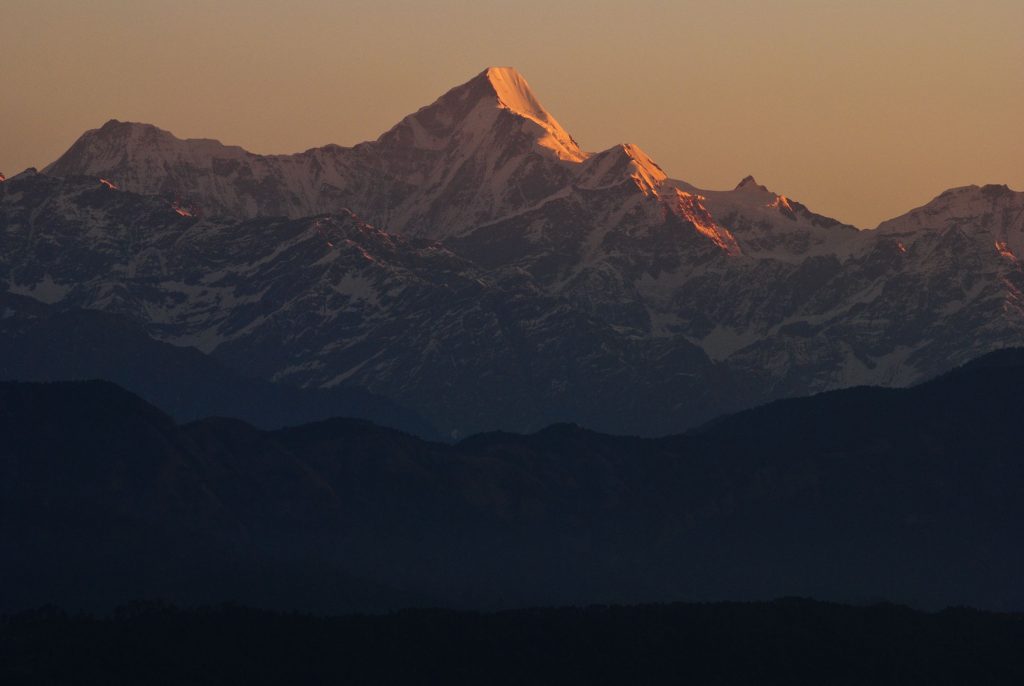
Yamunotri was the home of sage, Asit Muni. Yamuna is the daughter of the Surya (God of Sun) and Sarayyu. Her brother is Yama (God of Death). It is believed that Yama would not torment any individual at the time of death who bathes in Yamuna, his sister. It is Yamuna, holder of infinite love and compassion, who can grant us freedom from even death, in the realm of her elder brother.
After having visited the shrine and nearby places, you’ll return to Barkot for your onward journey.
Day 4: Barkot / Gangotri
This day begins with an early morning as well. If you’re not completely fit – you might feel fatigued from the previous day’s journey. Hence, I do recommend you get to bed early to get full night’s rest for your day today! Today’ you’ll be covering 210 KMs in about 9 hours’ worth of driving time. Do remember to take breaks. I particularly recommend stopping over at Gangnani – a hot water spring enroute. If you learn by 6 AM, you should hope to arrive at Gangotri by 3:30 PM.
Today is the day you visit your 2nd Dham, Gangotri, the origin of Ganga and seat of the goddess Ganga. The origin of the holy river is at Gaumukh, set in the Gangotri Glacier, and is a 19 km trek from Gangotri. According to Hindu mythology, Goddess Ganga took the form of a river to absolve the sins of King Bhagirath’s predecessors, following his severe penance to Shivji spanning several centuries. There is no other river as closely associated with Hinduism as Ganga. Respected since time immemorial as THE spiritual purifier, giver of health and prosperity – Ganga is part of the country’s religious fabric.
Visiting Gangotri is truly among the most blessed experiences of a Hindu’s life; and as uplifting and inspiring for any traveler.
Day 5 – Gangotri /Uttarkashi
Today, you may start your journey relatively leisurely. Waking up in Gangotri is an experience unto itself and should be treated as such. There are not many places where you feel peace quite like you’d here! Today, after taking in the experience as much as you can – you start your journey towards Uttarkashi. Uttarkashi literally translates to the Banaras (i.e. Kashi) of the North. Today’s journey will take you 4 hours to cover 95 KMs.
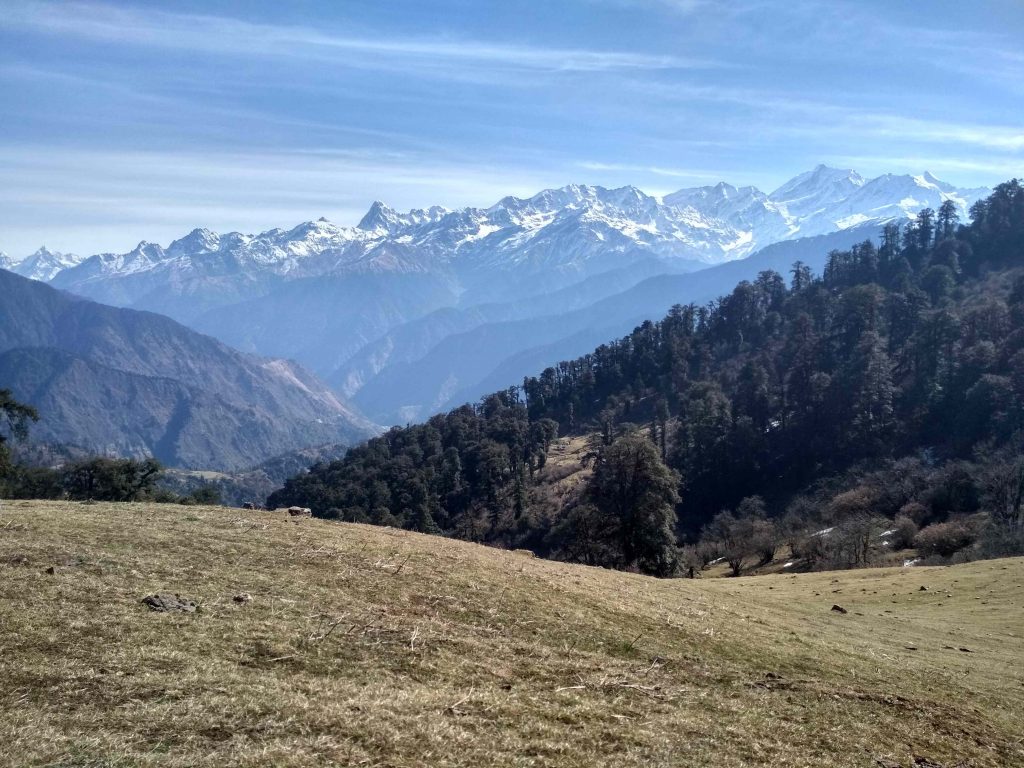
Uttarkashi, a small town at an elevation of 1588 mts, is situated between Varuna and Ashi rivers. These rivers slow into the Bhagirathi from either side of the town. Given its similarities to Kashi – the city enjoys similar ghats and temples like the city it is named after. When you’re here, do remember to visit the Vishwanath Temple, dedicated to Shivji. Other temples you must visit include Annapurna Temple and Bhairav Temple. Also, it is believed that in the second millennium of Kaliyug (the current ongoing yuga), Kashi (i.e. Banaras) will be submerged, and Uttarkashi will replace it as an important religious centre.
Day 6: Uttarkashi / Sitapur
Another day when you will have an early wakeup call & breakfast. Today you’ll be reaching your destination of Sitapur, covering 212 KMs worth of journey in around 10 hours of driving time. Sitapur is situated at an elevation of roughly 1820 mts, just 7 kms from Gaurikund and 26 kms from Guptkashi. Sitapur is situated only 2 kms from Son Prayag, lying at the confluence of Basuki and Mandakini rivers. It is said that a mere touch of the holy water from this holy site of Son Prayag helps the individual to attain the “Baikunth Dham”.
Another religiously important location is the Triyuginarayan – the marriage place of Lord Shiva and Parvati. This is situated at a distance of 14 kms by bus and 5 kms on foot from here.
In order to reach Kedarnath – you’ll be trekking from here. However, do remember to bathe in the hot water pond here and visit the Gauri Devi temple. This is the place where Goddess Parvati meditated to attain Lord Shiva.
Day 7: Sitapur/ Gaurikund/ Kedarnath
Today is going to be a long day with lots of physical activity! After an early breakfast you’ll proceed to Gaurikund, taking you two hours of driving time. Do remember to pack lunch and carry sufficient water for the day today. From Gaurikund, you will start your trekking in earnest. Overnight, you’ll be staying in Kedarnath (mostly accommodations are available since the destruction of 2013 floods). Overall, you’ll be covering 32 Kms from Sitapur to Gaurikund by driving and then another 14 KMS of trek. This entire journey will take you about 9 hours in total.
The third dham is possible the remotest dhams you’ll be covering. Located in Shivji’s own home – the shrine is majestic and the natural setting is breath-taking. From the towering mountains covered in snow, the plummeting streams and rivers, and lush green meadows and forests — and the arduous trek that gets you to it, serve to further cement the deep-rooted faith that this temple inspires! This site is almost unchanged for centuries and has a spiritual energy of its own! For the devotees of Shivji, this is the last frontier, the ultimate path to salvation!
For the trekking part a Horse & doli are both decent options in case you’re unable to manage the trek. The cost ranges from INR 1000 to 2500. Though these rates are subject to change dependent on the number of pilgrims and the time of your journey during the season.

Day 8: Kedarnath / Rudraprayag
Today, you’ll be moving from Kedarnath to Rudraprayad after an early morning breakfast at Gaurikund. Today’s journey will be 75 KMs along with a 14 Km trek. You should reach Gaurikund by 11 AM and Rudraprayad at 3:30 PM, if you leave from Kedarnath around 6 AM. You will be stopping at Sitapur for lunch.
What we know as Garhwal today was earlier known as the Kedar-Khand in the past. In fact, Puranas will tell you that Kedar-Khan is the abode of God. The scriptures of Ramayana and Mahabharata were scripted here.
Also, named after Shivji (Rudra), Rudraprayag is situated at the holy confluence of Alaknanda and Mandakini rivers, at a distance of 34 kms from Srinagar (Garhwal, UK). This confluence is particularly beautiful as if the two sisters are embracing each other! Here, it is believed that Narad Muni worshipped Shivji – who appeared here in his Rudra Avatar (incarnation) to bless Narad. The complete area is blessed with enormous natural splendor, places of sacred prominence, lakes and glaciers.
Day 9: Rudraprayag/ Badrinath
Not as early as yesterday – you’ll start your journey towards your final dham – Badrinath. After breakfast, you’ll be travelling a distance of 160 KMs, taking you around 8 hours of driving time to cover the distance! Ensure you leave early enough to reach Badrinath in time for evening Darshan and Pooja at the temple.
Badrinath and its route is a journey of beginning. The pilgrims visiting the spine always mention that the landmarks and vistas continually deliver a fresher view, a diverse feeling, an additional nuance to an experience. It is said that this is the toughest leg of the journey and often times, it can be unforgiving, but only to a closed minded person. The journey from Rishikesh to Badrinath, as Sir Edmund Hillary rightfully noted in his expeditions, is, in many ways, a journey from the ocean to the sky, as much mental as physical. And another route to heaven – and spiritual liberation.
Day 10: Badrinath / Birhi
Coming to a close for your spiritual awakening – you’ll have a leisurely morning wakeup call and only depart post lunch for Birhi. Today’s journey is 95 KMs, taking you 5 hours to complete.

Day 11: Birhi/Rishikesh
After breakfast at Birhi, proceed to Rishikesh. This journey will take you 160 KMs and 7 hours to complete.
It will be a brilliant idea to also explore Rishikesh while you’re here. Situated in the foothills of Himalayas, has some of the most pleasing views as well as the most soul calming vibes! With Ganga spreading the happiest of emotions around – Rishikesh truly is one of the most mesmerizing places in the country. Do remember that Rishikesh is a vegetarian city by law, as well as an alcohol-free city. In terms of places to visit – do remember to check out the oh-so-famous Laxman Jhulla, Ram jhulla and several ghats in and around this holy town.
Day 12: Rishikesh/Delhi
Head on back to your original location! Carry the peace, tranquility and happiness with you for a long time! The peace is quite like no other!
Char Dham Yatra Travel Tips
- Remember to check the exact opening and closing dates of the Yatra.
- Given that this Yatra holds immense importance for over a billion Hindus in the world – it is advisable that you remember to be kind along the way. For example, remember to cover your heads, remove before entering any holy place.
- Ensure you’re not littering anywhere on this trip. The hills and secluded locations need to be kept in their pristine conditions to ensure the bio-diversity of the region.
- Carry heavy woolen clothes to protect from cold weather during the month of October-November and carry moderate woolen during Summer Season. Remember to dress in layers as the weather can change at the drop of a hat in the hills.
- Do carry creams, moisturizers, sunscreen creams.
- Pack a medical kit with painkillers, antibiotics, cough lozenges, Antiseptic cream, Iodine, tube-squeeze cream and medicines for cold and fever along with your routine medicines.
- Remember to pack snacks.
- Do not take pictures if cameras are not allowed in any particular area. Do not play with the sentiments of any particular religion.
- At least a month before the Yatra, it is advisable to start preparatory exercises
- Carry extra batteries and films for your camera, as electricity is not regular in such remote places.
- Do not travel in the rainy season as there are a lot of landslides during that time.
- Book hotel rooms in advance if you are travelling close to the temple opening dates, there is a heavy rush of pilgrims.
- Alcohol or non-vegetarian food is not permitted during Char Dham Yatra Tour.

Conclusion
The Chota Char Dham Yatra is one of the most significant journeys in the life of a Hindu. Situated in the Garhwal region of Uttarakhand, you can cover the entire Yatra in a matter of 10-15 days. I hope you have attained a lot of information about how to cover the journey. I will be writing more about each of the dhams in the coming posts. Do let me know in case there are certain things you’d like me to cover and elaborate in detail.
[ad_2]
